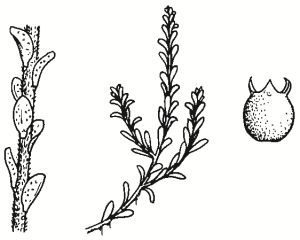Family:
Myrtaceae
Kunzea parvifolia
Violet Kunzea
Other Names:

Name Origin:
Kunzea — after Dr Gustav Kunze (1793-1851), professor of medicine and botany, Leipzig.
parvifolia — from Latin parvus, small, and foli, leaf, referring to small leaves.
Regional Subspecies:
Occurrence:
Regional:
Noted east of the Hume Highway in the areas: Yarra Yarra; Four Mile; Lunts-Sugarloaf; Coppabella; Ournie; Tooma; Ardenside-Welaregang; Carabost, and Gilmore Lower and Sandy.
Australia:
NSW, Vic.
Habitat:
Heath and dry sclerophyll forest.
Habit:
Erect shrub to 1.5 m high with slender wiry reddish branches and small leaves mostly 1-3.5 mm long. Forms thickets similar to tea-tree scrub.
Site Preference:
Rocky slopes, especially near seepage areas.
Characteristics:
Very hardy.
Flowering:
Pink to purple (rarely white), spring-early summer.
Seed Collection:
Early Jan — late May. Monitor closely as seeds shed 3-14 days after maturity.
Propagation:
From seed, sown early autumn, or cuttings about 10 cm long in Jan. Rooting hormones should enhance strike rate. Most Kunzeas germinate readily in 3-5 weeks. Surface sow or cover lightly. Capillary watering may be beneficial.
VALUES:
Shade & Shelter:
Useful low-level cover in windbreaks.
Land Protection:
Stabilises soil.
Wildlife:
Good habitat. Foliage excellent refuge for small birds. Flowers are a nectar source for honeyeaters and other native birds.
Ornamental:
Attractive when flowering. Regular pruning beneficial.
